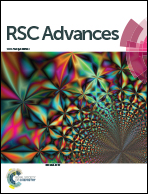Polyimide nanocomposites with functionalized SiO2 nanoparticles: enhanced processability, thermal and mechanical properties†
Abstract
SiO2–polyimide nanocomposites were successfully fabricated by surface modification of silica nanoparticles. In order to create structural similarity between the polymer and the SiO2 surface and to generate interfacial interaction with the polymer chain, (3-trimethoxysilylpropyl)diethylenetriamine was attached to the surface, and then, the surface amines were reacted with phthalic anhydride. The modified silica nanoparticles in polyamic acid solution were subjected to thermal imidization to obtain SiO2–polyimide (PI) nanocomposite films. Cross-sectional transmission electron microscopy results showed no significant aggregation in any of the SiO2–PI nanocomposite films having up to 20 wt% of silica nanoparticles. The effects of silica nanoparticles as a filler material on the thermal, optical, and mechanical properties of the SiO2–PI nanocomposite films were studied in comparison with those of PI by UV-vis spectrometry, thermal gravimetric analysis, thermal mechanical analysis, and nanoindentation.


 Please wait while we load your content...
Please wait while we load your content...